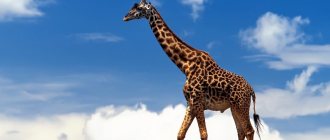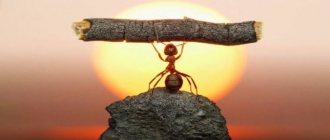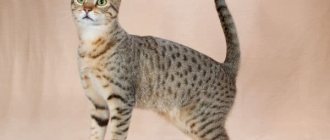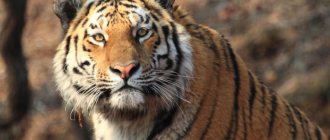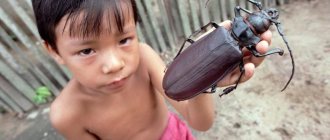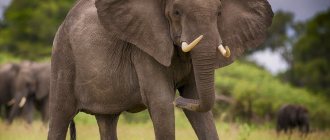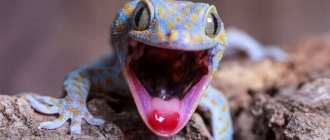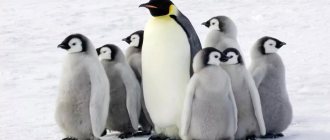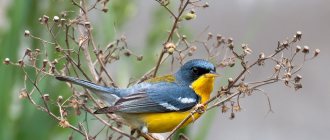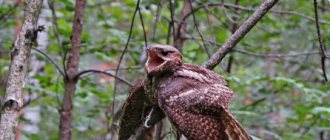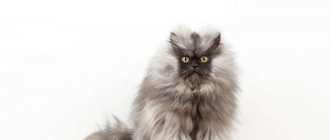The fauna of our planet is so beautiful that such incredible diversity is simply breathtaking. How to learn more about the animal world, which is fraught with so much unknown? Interesting information about animals on our website will help with this.
The animal kingdom is home to a huge variety of different creatures. They are amazing, funny and beautiful. In this category you will find all the most interesting things about animals, you will learn a lot of new and amazing things about them.
Don't forget to share with your friends!
Crocodile tears or what is the crocodile crying about?
25 January40712interesting about animalscrocodilepredator
In the Russian language there is such a phrase as “crocodile tears”, which each of us has probably heard at least once. This phrase paints before us the image of a crocodile shedding tears and wiping them with a handkerchief. What does the expression “crocodile tears” mean? Do crocodiles really cry? Below you will find answers to all these questions.
Read more
Why is the lion the king of beasts?
13 March78095interesting about animals lionpredatordangerous
Ask anyone what animal on our planet bears the proud title of king of beasts, and each of them will answer that it is a lion. It is this big cat from the panther family that occupies such a high position. But why is the lion the king of beasts? The lion is a predatory representative of the cat family, one of the smartest, fastest and largest animals. In this article we will tell you why the lion is the king of beasts.
Read more
Appearance and body structure
Today the number of mammals exceeds more than four thousand species . They are characterized by characteristics unique to them, determined by their physiology.
The body of such animals is covered with hair, which can be different, coarse or fine, straight or wavy, short or long. Moles have undercoat. Periodically, such animals experience molting, during which the thickness of the fur and the color itself change. Under the skin there are special hair follicles, glands, scales or horn formations.
The structure of the skeleton is distinguished by the presence of limbs under the body, due to which mammals can move very quickly.
Besides:
- The skull is filled with a well-developed braincase.
- The jaw cells contain strong teeth. They are divided into lateral, incisor and canine teeth.
- Seven vertebrae, which are movably connected to each other, make up the cervical spine. The two sacral and caudal vertebrae form into one large bone. Fifteen ribs are well connected to the thoracic vertebrae.
- Many animals have paired shoulder blades located in the forelimbs.
- Two bones form the pelvis.
Mammals have ears that are quite developed, with the help of which they practically “hear” smells and determine direction. The eyes have eyelids and eyelashes. The belly and head are covered with stiff hairs . They enable the animal to feel even minor touches well.
Bear's hibernation, or why does a bear suck its paw?
28 November36565interesting about animalsbearhibernation
Everyone knows that the bear is an animal that traditionally hibernates in winter. Since ancient times, people have formed the opinion that during hibernation a bear sucks its paw. It was implied that the bears were doing this because they were hungry. Over time, the expression “paw sucking” has become a catchphrase, which is quite often used in the modern world, meaning to lead a poor life. So what do bears actually do during hibernation and how does it happen? In this article we will talk about this.
Read more
Fourth place - leopard
Leopard
The most unpredictable and aggressive representative of the big cat subfamily is the leopard. Having a height at the withers of 45–78 cm and a weight of up to 75 kg, this hunter with red spotted fur and a long tail is inferior in size to its relatives - the tiger and lion. However, strong jaws and a bite force of 100–125 atmospheres put the leopard on a par with the most predatory animals on the planet. The leopard is one of the largest cats in the world - more details in our article.
The graceful, dangerous cat lives in mountainous, forest-steppe and forest regions of Africa, East Asia, the Far and Middle East. The leopard is the ideal hunter of the fauna world, whose skills are honed to the smallest detail. The animal goes out hunting at night and watches for prey for hours, burying itself in thickets or treetops. Having discovered the victim, it overtakes it with a giant leap.
The animal's strong neck allows it to drag prey twice the hunter's body weight. Even with a dead antelope weighing 80 kg in its teeth, the leopard reaches speeds of up to 57 km/h and makes three-meter high jumps. The predator always drags its trophy up a tree for a subsequent meal.
How to walk dogs during COVID-19 coronavirus?
04 April21268interesting about animalscoronavirus walking
Spring 2022 has not started off easy. Quarantines are being introduced all over the world, and the number of people infected with coronavirus is growing every day. During this time, it is advisable to stay at home. But many families have dogs that require daily walks. What to do in this situation? In this article, we will try to tell you the basic rules for walking dogs during the COVID-19 coronavirus, as well as the precautions that should be taken after walking.
Read more
Animals for Halloween: what to do with a pumpkin?
31 October 1685interesting about animalsHalloween
Halloween is a big holiday with a fascinating history, rich in traditions and various legends; on this day it is customary to dress up and decorate the house with appropriate paraphernalia. But animals don’t get bored on Halloween either... Everyone knows that the most popular symbol of this holiday is the pumpkin. Let's see how animals react to surprises prepared for them...
Read more
LIST OF ANIMALS NAMES
First column
-
names given by M. V. Pevtsov;
the second column -
the most currently accepted Latin names corresponding to the species mentioned by the author;
third column -
Russian names. Species marked in the second column with the words “the same” are currently indicated under the same names that were adopted in the time of M.V. Pevtsov.
| Actitis hypoleucus | Tringa hypoleucos | carrier | ||||
| Acanthis linaria | Acanthis flammea | tap dance | ||||
| Aegialites minor | Charadrius dubius | little plover | ||||
| Aegialifes placidus | Charadrius placidus | Ussuri plover | ||||
| Alauda albigula | Eremophila alpestris | horned lark | ||||
| Alauda arvensis | Also | skylark | ||||
| Alcedo bengalensis | Alcedo atthis | kingfisher | ||||
| Anas boschas | Anas plathyrhychos | mallard | ||||
| Anas clypeata | Also | Shoveler | ||||
| Anas penelope | Also | wigeon | ||||
| Anas querquedula | Also | teal | ||||
| Anas strepera | Also | gray duck | ||||
| Anodonta anatina | Also | toothless | ||||
| Anser cinereus | Anser anser | grey goose | ||||
| Anser cygnoides | Cygnopsis cygnoides | dry goose | ||||
| Anser indicus | Also | mountain goose | ||||
| Antelope saiga | Saiga tatarica | saiga | ||||
| Aquila fulva | Aquila chrysaetus | golden eagle | ||||
| Arctomys baibacina | Marmota baibacina | asian marmot | ||||
| Ardea alba | Egretta alba | egret | ||||
| Athene plumipes | Athene noctua | little owl | ||||
| Aythia ferina | Nyroca ferina | red-headed pochard | ||||
| Bombycilla garulla | Bombycilla garullus | waxwing | ||||
| Bos grunniens | Poephagus grunniens | yak | ||||
| Branta rufina | Netta rufina | red-nosed pochard | ||||
| Budytes citreola | Motacilla citrusola | yellow-headed wagtail | ||||
| Buteo hemilasius | Also | Central Asian buzzard | ||||
| Budytes campestris | Motacilla flava | yellow wagtail | ||||
| Canis corsac | Vulpes corsac | corsac | ||||
| Capra sibirica | Also | Mountain goat | ||||
| Capra pallasii | Capra sibirica | Mountain goat | ||||
| Casarca rutila | Casarca ferruginea | red duck | ||||
| Cervus elaphus sibiricus | Also | maral | ||||
| Cervus pygargus | Capreolus capreolus | roe | ||||
| Charadrius xanthocheilus | Charadrius dominicus | brown-winged plover | ||||
| Cinclus leucogaster | Cinclus cinclus | dipper | ||||
| Circus cianeus | Also | Hen Harrier [278] | ||||
| Circus rufus | Circus aeruginosus | marsh harrier | ||||
| Colaeus dauricus | Colaeus monedula | jackdaw | ||||
| Columba livia | Also | rock pigeon | ||||
| Columba rupestris | Also | stone pigeon | ||||
| Columba turtur | Streptopelia turtor | turtle dove | ||||
| Corvus cornix | Corvus corone | crow | ||||
| Corvus orientalis | Corvus corone | crow | ||||
| Corvus monedula | Colaeus monedula | jackdaw | ||||
| Coturnix dactylisonans | Coturnix coturnix | quail | ||||
| Cuculus canorus | Also | cuckoo | ||||
| Cygnus musicus | Cygnus cygnus | whooper swan | ||||
| Cypselus apus | Apus apus | swift | ||||
| Dipus jaculus | Allactaga jaculus | big jerboa | ||||
| Dafila acuta | Anas acuta | pintail | ||||
| Emberiza cioides | Also | red-eared bunting | ||||
| Emberiza pusilla | Also | oatmeal crumble | ||||
| Equus hemionus | Also | kulan | ||||
| Eudramias morinellus | Charadrius morinellus | crystal | ||||
| Eudrornias veredus | Charadrius vereda | long-legged plover | ||||
| Euspiza aureola | Emberiza aureola | Dubrovnik | ||||
| Grus cinerea | Grus grus | gray crane | ||||
| Grus virgo | Anthropoides virgo | demoiselle crane | ||||
| Falco tinnunculus | Also | kestrel | ||||
| Felis manul | Also | manul | ||||
| Fregilegus graculus | Pyrrhocorax graculus | alpine jackdaw | ||||
| Fulica atra | Also | coot | ||||
| Fuligula leucophthalmos | Nyroca nyroca | white-eyed duck | ||||
| Haliaetus albicilla | Also | white-tailed eagle | ||||
| Haliaetus leucoryphus | Also | long-tailed eagle | ||||
| Hirundo riparia | Riparia riparia | shore swallow | ||||
| Hydrochelidon fissipes | Hydrochelidon leucoptera | white-winged tern | ||||
| Lanius sphenocercus | Also | wedge-tailed shrike | ||||
| Larus cachinans | Larus argentatus | herring gull | ||||
| Larus ridibundus | Also | common gull | ||||
| Lepus tolai | Also | tolai hare | ||||
| Lepus variabilis | Lepus timidus | white hare | ||||
| Leuciscus sp. | Also | |||||
| Limnaeus stagnalis | Also | |||||
| Limosa melanuroides | Limosa limosa | great godwit | ||||
| Limnaeus ovata | Also | |||||
| Lobipes hyperboreus | Phalaropus lobatus | round-nosed phalarope | ||||
| Machetes pugnax | Philomachus pugnax | turukhtan | ||||
| Mareca penelope | Anas penelope | wigeon | ||||
| Megaloperdix himalayanus | Tetraogallus himalayensis | Himalayan snowcock | ||||
| Melanocoryhpa mongolica | Melanocorypha mongolica | Mongolian lark | ||||
| Melanocoryhpa tatarica | Melanocorypha yeltoniensis | black lark | ||||
| Meles taxus | Meles meles | badger | ||||
| Mergus merganser | Also | merganser | ||||
| Micropalama taezanowskyi | Macrorhamphus semipalmatus | Godwit | ||||
| Milvus govinda | Milvus korschun | black kite | ||||
| Milvus melonotis | Milvus korschun | black kite | ||||
| Motacilla bukhunensis | Motacilla alba | white wagtail | ||||
| Motacilla personata | Motacilla alba | white wagtail | ||||
| Mustela alpina | Mustela altaica | Solonga | ||||
| Mustela vulgaris | Mustela nivalis | weasel | ||||
| Nemachilus | Also | loach | ||||
| Net ion crecca | Anas crecca | teal-whistle | ||||
| Nucifraga caryocatactes | Also | nutcracker | ||||
| Ortigometra porzana | Porzana Porzana | Crake | ||||
| Otis macqueni | Chlamydotis undulata | Jack | ||||
| Otis tarda | Also | bustard | ||||
| Otis tetrax | Also | little bustard | ||||
| Otocoris brandtii | Eremophila alpestris | horned lark | ||||
| Ovis argali | Ovis ammon | Mountain sheep | ||||
| Ovis karelini | Ovis ammon | Mountain sheep [279] | ||||
| Parus cyanus | Also | blue tit | ||||
| Parus major | Also | big tit | ||||
| Parus pendulinus | Remiz pendulinus | heald | ||||
| Pelecanus onocrotalus | Also | pink pelican | ||||
| Perdix barbata | Perdix daurica | bearded partridge | ||||
| Perdix chukar | Alectoris graeca | chukar | ||||
| Perdix cinerea | Perdix perdix | gray partridge | ||||
| Petrocincla saxatilis | Monticola saxatilis | rock thrush | ||||
| Phalacrocorax carbo | Also | cormorant | ||||
| Phasianus torquatus | Phasianus colchicus | pheasant | ||||
| Phyllopneuste tristis | Phylloscopus collybitus | grasshopper warbler | ||||
| Pica caudata | Pica pica | magpie | ||||
| Picus leuconotus | Dryobates leucotus | white-backed woodpecker | ||||
| Podoces hendersoni | Also | saxaul jay | ||||
| Pratincola rubicola | Saxicola torquata | stonechat | ||||
| Pterocles arenarius | Pterocles orientalis | black-bellied sandgrouse | ||||
| Recurvirostra avocetta | Also | avocet | ||||
| Rhombomys opimus | Also | great gerbil | ||||
| Rhynchaspis clypeata | Anas clypeata | Shoveler | ||||
| Ruticilla erythronota | Ruticilla erythronotus | rufous-backed redstart | ||||
| Querquedula circia | Anas querquedula | teal | ||||
| Saxicola deserti | Oenanthe deserti | desert wheatear | ||||
| Saxicola isabellina | Oenanthe isabellina | Wheatear | ||||
| Saxicola oenanthe | Oenanthe oenanthe | heater | ||||
| Scolopax gallinago | Capella gallinago | snipe | ||||
| Scolopax hyemalis | Capeila solitaria | mountain snipe | ||||
| Syrrhaptes paradoxus | Also | sadja | ||||
| Spermophilus mugodjaricus | Citellus pygmaeus | gray gopher | ||||
| Squaterola helvetica | Squaterola squaterola | Tules | ||||
| Strepsilas collaris | Arenaria interpres | stone picker | ||||
| Sterna fluviatilis | Sterna hirundo | common tern | ||||
| Sterna leucoptera | Chlidonias leucoptera | white-winged tern | ||||
| Sterna longipennis | Also | black-billed tern | ||||
| Sturnus unicolor | Sturnus vulgaris | starling | ||||
| Sturnus vulgaris | Also | starling | ||||
| Sus scrofa | Also | boar | ||||
| Tamias striatus | Eutamias sibiricus | chipmunk | ||||
| Tetrao tetrix | Lyrus tetrix | black grouse | ||||
| Totanus calidris | Tringa totanus | herbalist | ||||
| Totanus glareola | Tringa glareola | FIFA and | ||||
| Totanus glottis | Tringa nebularia | big snail | ||||
| Tringa temminskii | Calidris temminckii | white-tailed sandpiper | ||||
| Totanus ochropus | Tringa ochropus | blackie | ||||
| Turdus atrigularis | Turdus ruficollis | dark-throated blackbird | ||||
| Turdus fuscatus | Turdus naumanni | black-throated blackbird | ||||
| Turdus hodgsoni | Turdus viscivorus | blackbird mistletoe | ||||
| Turdus mystacinus | Turdus ruficollis | dark-throated blackbird | ||||
| Upupa epops | Also | hoopoe | ||||
| Vanellus cristatus | Vanellus vanellus | lapwing | ||||
| Vanellus gregarius | Chrttusia gregaria | lapwing | ||||
| Vulpes hypomelus | Vulpes vulpes | fox | ||||
| Vulpanser tadorna | Tadorna Tadorna | shelduck [280] | ||||
LIST OF PLANT NAMES
The first column is the names given by M. V. Pevtsov; the second column - the most currently accepted Latin names corresponding to the species mentioned by the author; third column
—
Russian names. Species marked in the second column with the words “the same” are currently indicated under the same names that were adopted in the time of M.V. Pevtsov.
| Anemone narcissiflora | Also | anemone, anemone |
| Artemisia arenaria | Also | sand wormwood |
| Berberis heteropoda | Also | barberry |
| Betula nana | Also | dwarf birch |
| Caragana frutescens | S. erinacea | caragana prickly |
| Cotoneaster vulgaris | S. integerima | cotoneaster |
| Crataegus pinnatifida | S. altaica v. incisa | Altai hawthorn |
| Haloxylon ammodendron | Also | zaisan saxaul |
| Juniperus sp. | Also | juniper |
| Lasiagrostis sp. | Also | whose brilliant, derisun |
| Lonicera tatarica | Also | Tatarian honeysuckle |
| Papaver alpinum | P. nudicaule | alpine poppy |
| Picea schrenkiana | Also | Tien Shan spruce |
| Populus alba | Also | white poplar |
| Populus laurifolia | Also | laurel poplar |
| Populus nigra | Also | black poplar |
| Populus tremula | Also | aspen |
| Ranunculus hiperboreus | Also | buttercup |
| Ribus nigrum | Rubes nigrum | black currant |
| Ribus rubrum | Rubes rubrum | Red currants |
| Rosa leucanta | ||
| Salix ftagilis | Also | brittle willow |
| Sorbus aucuparia | Also | mountain ash |
| Spiraea crenata | Also | spiraea |
| Spiraea hipericifolia | Also | meadowsweet |
| Stipa orientalis | Also | eastern feather grass |
| Ulmus pumila | Also | elm (berest) squat |
| Viola biflora | Also | bicolor violet, Ivan da Marya |
